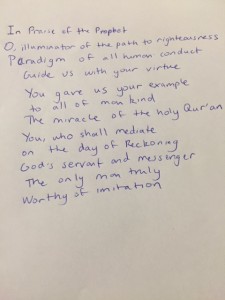Learning about the Prophet Muhammad and his influence on the way in which Muslims everywhere choose to live their lives was highly intriguing to me. I found it incredibly moving that so many people venerate the Prophet although, as is unique to Islam, he is not to be seen as more than a human being, or likened to a deity. Instead, the vast majority of Muslims view the Prophet Muhammad as a paradigm for humanity whose qualities should be instilled. In class we learned about how many adherents of Islam express their love for and veneration of the Prophet through poetry and art. In particular, I was drawn to the idea of a na’t, which are poems highly common among Urdu poets. These na’ts are utilized to extoll the Prophet Muhammad’s many virtues. In this creative response, I had hoped to write a poem similar to a na’t that would showcase the Prophet’s many virtues and encapsulate how he is regarded by the Muslim population. Throughout the poem I wrote, I included information about how, as discussed in the previous blog post, the Prophet Muhammad signifies different roles to different Muslims. For instance, some believe him to be an intercessor on the Day of the Reckoning that would intercede on behalf of humanity, whereas many others see this as a transgression from human to deity that contradicts the notion of God’s oneness.